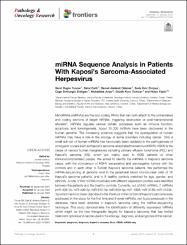miRNA Sequence Analysis in Patients With Kaposi's Sarcoma-Associated Herpesvirus

Göster/
Erişim
info:eu-repo/semantics/openAccessAttribution-NoDerivs 3.0 United Stateshttp://creativecommons.org/licenses/by-nd/3.0/us/Tarih
2022Yazar
Tunçer, Şeref BuğraÇelik, Betül
Akdeniz Ödemiş, Demet
Kılıç Erciyas, Seda
Şükrüoğlu Erdoğan, Özge
Avşar, Mukaddes
Kuru Türkcan, Gözde
Yazıcı, Hülya
Üst veri
Tüm öğe kaydını gösterKünye
Tuncer, S. B., Celik, B., Akdeniz Odemis, D., Kılıc Erciyas, S., Sukruoglu Erdogan, O., Avsar, M., . . . Yazici, H. (2022). miRNA sequence analysis in patients with Kaposi’s sarcoma-associated herpesvirus. Pathology and Oncology Research, 28 doi:10.3389/pore.2022.1610055Özet
MicroRNAs (miRNAs) are the non-coding RNAs that can both attach to the untranslated and coding sections of target mRNAs, triggering destruction or post-transcriptional alteration. miRNAs regulate various cellular processes such as immune function, apoptosis, and tumorigenesis. About 35,000 miRNAs have been discovered in the human genome. The increasing evidence suggests that the dysregulation of human miRNAs may have a role in the etiology of some disorders including cancer. Only a small sub-set of human miRNAs has functionally been validated in the pathogenesis of oncogenic viruses such as Kaposi’s sarcoma-associated herpesvirus (KSHV). KSHV is the cause of various human malignancies including primary effusion lymphoma (PEL) and Kaposi’s sarcoma (KS), which are mainly seen in AIDS patients or other immunocompromised people. We aimed to identify the miRNAs in Kaposi’s sarcoma cases, with the comparison of KSHV seropositive and seronegative tumors with the controls and in each other in Turkish Kaposi’s sarcoma patients. We performed the miRNA-sequencing at genome level in the peripheral blood mononuclear cells of 16 Kaposi’s sarcoma patients, and in 8 healthy controls matched for age, gender, and ethnicity. A total of 642 miRNA molecules with different expression profiles were identified between the patients and the healthy controls. Currently, out of 642 miRNAs, 7 miRNAs (miR-92b-3p, miR-490-3p, miR-615-3p, miR-629-5p, miR-1908, miR-3180, miR-4433b-3p) which have not been described in the literature in the context of Kaposi’s sarcoma were addressed in the study for the first time and 9 novel miRNAs, not found previously in the database, have been detected in Kaposi’s sarcoma using the miRNA-sequencing technique. This study demonstrates the identification of differently expressed miRNAs which might be the new therapeutic targets for Kaposi’s sarcoma, that has limited treatment options and can be used in the etiology, diagnosis, and prognosis of this cancer.
Kaynak
Pathology and Oncology ResearchCilt
28Koleksiyonlar
Aşağıdaki lisans dosyası bu öğe ile ilişkilidir:


















